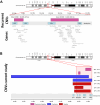Evaluation of 100 Dutch cases with 16p11.2 deletion and duplication syndromes; from clinical manifestations towards personalized treatment options
- PMID: 38605127
- PMCID: PMC11576736
- DOI: 10.1038/s41431-024-01601-2
Evaluation of 100 Dutch cases with 16p11.2 deletion and duplication syndromes; from clinical manifestations towards personalized treatment options
Abstract
The 16p11.2 deletion syndrome is a clinically heterogeneous disorder, characterized by developmental delay, intellectual disability, hyperphagia, obesity, macrocephaly and psychiatric problems. Cases with 16p11.2 duplication syndrome have similar neurodevelopmental problems, but typically show a partial 'mirror phenotype' with underweight and microcephaly. Various copy number variants (CNVs) of the chromosomal 16p11.2 region have been described. Most is known about the 'typical' 16p11.2 BP4-BP5 (29.6-30.2 Mb; ~600 kb) deletions and duplications, but there are also several published cohorts with more distal 16p11.2 BP2-BP3 CNVs (28.8-29.0 Mb; ~220 kb), who exhibit clinical overlap. We assessed 100 cases with various pathogenic 16p11.2 CNVs and compared their clinical characteristics to provide more clear genotype-phenotype correlations and raise awareness of the different 16p11.2 CNVs. Neurodevelopmental and weight issues were reported in the majority of cases. Cases with distal 16p11.2 BP2-BP3 deletion showed the most severe obesity phenotype (73.7% obesity, mean BMI SDS 3.2). In addition to the more well defined typical 16p11.2 BP4-BP5 and distal 16p11.2 BP2-BP3 CNVs, we describe the clinical features of five cases with other, overlapping, 16p11.2 CNVs in more detail. Interestingly, four cases had a second genetic diagnosis and 18 cases an additional gene variant of uncertain significance, that could potentially help explain the cases' phenotypes. In conclusion, we provide an overview of our Dutch cohort of cases with various pathogenic 16p11.2 CNVs and relevant second genetic findings, that can aid in adequately recognizing, diagnosing and counseling of individuals with 16p11.2 CNVs, and describe the personalized medicine for cases with these conditions.
© 2024. The Author(s).
Conflict of interest statement
Figures



References
-
- Taylor CM, Smith R, Lehman C, Mitchel MW, Singer K, Weaver WC, et al. 16p11.2 Recurrent Deletion. In: Adam MP, Ardinger HH, Pagon RA, Wallace SE, Bean LJH, Mirzaa G, Amemiya A, editors. GeneReviews(®). Seattle (WA): University of Washington, Seattle Copyright © 1993-2021, University of Washington, Seattle. GeneReviews is a registered trademark of the University of Washington, Seattle. All rights reserved.; 1993.
MeSH terms
Supplementary concepts
Grants and funding
LinkOut - more resources
Full Text Sources
Miscellaneous

